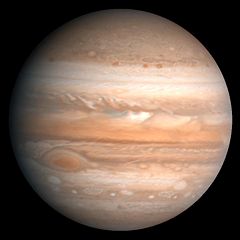Moons of Jupiter

Jupiter has 62 confirmed moons, giving it the largest retinue of moons with "reasonably secure" orbits of any planet in the Solar System.[1] The most massive of them, the four Galilean moons, were discovered in 1610 and were the first objects found to orbit a body that was neither Earth nor the Sun. From the end of the 19th century, dozens of much smaller Jovian moons have been discovered and have received the names of lovers, conquests, or daughters of the Roman god Jupiter, or his Greek equivalent, Zeus.
Eight of Jupiter's moons are regular satellites, with prograde and nearly circular orbits that are not greatly inclined with respect to Jupiter's equatorial plane. The Galilean satellites are spheroidal in shape, and so would be considered dwarf planets if they were in direct orbit about the Sun. The other four regular satellites are much smaller and closer to Jupiter; these serve as sources of the dust that makes up Jupiter's rings.
Jupiter's other 54 or 55 moons are tiny irregular satellites, whose prograde and retrograde orbits are much farther from Jupiter and have high inclinations and eccentricities. These moons were likely captured by Jupiter from solar orbits. There are 13 recently-discovered irregular satellites that have not yet been named, plus a 14th whose orbit has not yet been established; if it is, the number of secured moons will rise to 63.
Contents |
Characteristics

The moons' physical and orbital characteristics vary widely. The four Galileans are all over 3000 km in diameter; the largest Galilean, Ganymede, is the largest object in the Solar System outside the Sun and the eight planets. All other Jovian moons are less than 250 km in diameter, with most barely exceeding five km. Even Europa, the smallest of the Galileans, is five thousand times more massive than all the non-Galilean moons combined. Orbital shapes range from nearly perfectly circular to highly eccentric and inclined, and many revolve in the direction opposite to Jupiter's spin (retrograde motion). Orbital periods range from seven hours (taking less time than Jupiter does to spin around its axis), to some 3000 times more (almost three Earth years).
Discovery

The first claimed observation of one of Jupiter's moons is that of the Chinese astronomer Gan De around 364 BC.[2] However, the first certain observations of Jupiter's satellites were those of Galileo Galilei in 1609.[3] By March 1610, he had sighted the four massive Galilean moons with his 30x magnification telescope:[4] Ganymede, Callisto, Io, and Europa. No additional satellites were discovered until E.E. Barnard observed Amalthea in 1892.[5] With the aid of telescopic photography, further discoveries followed quickly over the course of the twentieth century. Himalia was discovered in 1904,[6] Elara in 1905,[7] Pasiphaë in 1908,[8] Sinope in 1914,[9] Lysithea and Carme in 1938,[10] Ananke in 1951,[11] and Leda in 1974.[12] By the time Voyager space probes reached Jupiter around 1979, 13 moons had been discovered, while Themisto was observed in 1975,[13] but due to insufficient initial observation data, it was lost until 2000. The Voyager missions discovered an additional three inner moons in 1979: Metis, Adrastea, and Thebe.[14]
For two decades no additional moons were discovered; but between October 1999 and February 2003, researchers using sensitive ground-based detectors found another 32 moons, most of which were discovered by a team lead by Scott S. Sheppard and David C. Jewitt.[15] These are tiny moons, in long, eccentric, generally retrograde orbits, and average of 3 km (1.9 mi) in diameter, with the largest being just 9 km (5.6 mi) across. All of these moons are thought to be captured asteroidal or perhaps cometary bodies, possibly fragmented into several pieces,[16] but very little is actually known about them. A number of 14 additional moons were discovered since then, but not yet confirmed, bringing the total number of observed moons of Jupiter at 63.[17] As of 2008, this is the most of any planet in the Solar System, but additional undiscovered, tiny moons may exist.
Naming
The Galilean moons of Jupiter (Io, Europa, Ganymede and Callisto) were named by Simon Marius soon after their discovery in 1610.[18] However, until the 20th century these fell out of favor, and instead they were referred to in the astronomical literature simply as "Jupiter I", "Jupiter II", etc., or as "the first satellite of Jupiter", "Jupiter's second satellite", an so on.[18] The names Io, Europa, Ganymede, and Callisto became popular in the 20th century, while the rest of the moons, usually numbered in Roman numerals V (5) through XII (12), remained unnamed.[19] By a popular though unofficial convention, Jupiter V, discovered in 1892, was given the name Amalthea, first used by the French astronomer Camille Flammarion.[15]
The other moons, in the majority of astronomical literature, were simply labeled by their Roman numeral (i.e. Jupiter IX) until the 1970s.[20] In 1975, the International Astronomical Union's (IAU) "Task Group for Outer Solar System Nomenclature" granted names to satellites V–XIII,[21] and provided for a formal naming process for future satellites to be discovered.[21] The practice was to name that newly discovered moons of Jupiter after lovers and favorites of the god Jupiter (Zeus), and since 2004, after their descendants also.[22] All of Jupiter's satellites from XXXIV (Euporie) are named after daughters of Jupiter or Zeus.[22]
Some asteroids share the same names as moons of Jupiter: 9 Metis, 38 Leda, 52 Europa, 85 Io, 113 Amalthea, 239 Adrastea. Two more asteroids previously shared the names of Jovian moons until spelling differences were made permanent by the IAU: Ganymede and asteroid 1036 Ganymed; and Callisto and asteroid 204 Kallisto.
Groups
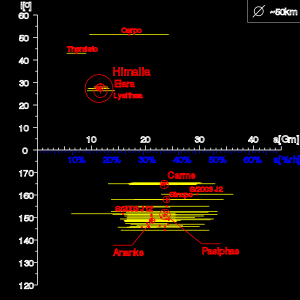
Regular satellites
These are split into two groups:
-
- Inner satellites or Amalthea group — they orbit very close to Jupiter: Metis, Adrastea, Amalthea, and Thebe. The innermost two orbit in less than a Jovian day, while the latter two are respectively the fifth and seventh largest moons in the system. Observations suggest that at least the largest member, Amalthea, did not form on the present orbit, but that it was formed farther from the planet, or that it is a captured Solar System body.[23] These moons, along with a number of as-yet-unseen inner moonlets, replenish and maintain Jupiter's faint ring system. Metis and Adrastea help to maintain Jupiter's main ring, while Amalthea and Thebe each maintain their own faint outer rings.[24][25]
-
- Main group or Galilean moons — the four massive satellites: Ganymede, Callisto, Io, and Europa. With radii that are larger than any of the dwarf planets, they are some of the largest objects in the Solar System outside the Sun and the eight planets in terms of diameter. Respectively the first, third, fourth, and sixth largest natural satellites in the Solar System, they contain almost 99.999% of the total mass in orbit around Jupiter. The inner moons also participate in a 1:2:4 orbital resonance. Models suggest that they formed by slow accretion in the low-density Jovian subnebula—a disc of the gas and dust that existed around Jupiter after its formation—which lasted up to 10 million years in the case of Callisto.[26]
Irregular satellites

The irregular satellites are substantially smaller objects with more distant and eccentric orbits. They form families with shared similarities in orbit (semi-major axis, inclination, eccentricity) and composition; it is believed that these are at least partially collisional families that were created when larger (but still small) parent bodies were shattered by impacts from asteroids captured by Jupiter's gravitational field. These families bear the names of their largest members. The identification of satellite families is tentative, but the following are typically listed:[17][27][28]
- Prograde satellites:
-
- The Himalia group is spread over barely 1.4 Gm in semi-major axis, 1.6° in inclination (27.5 ± 0.8°), and eccentricities between 0.11 and 0.25. It has been suggested that the group could be a remnant of the break-up of an asteroid from the main asteroid belt.[27]
-
- Carpo is the outermost prograde moon and not part of a known family.[17]

- The irregular retrograde satellites are thought to have originally been asteroids that were captured by drag from the tenuous outer regions of Jupiter's accretion disk while the Solar system was still forming, and were later shattered by impacts. They are far enough from Jupiter that their orbits are significantly disturbed by the gravitational field of the Sun.
-
- S/2003 J 12 is the innermost of the retrograde moons, and is not part of a known family.
-
- The Ananke group has a relatively wider spread than the previous groups, over 2.4 Gm in semi-major axis, 8.1° in inclination (between 145.7° and 154.8°), and eccentricities between 0.02 and 0.28. Most of the members appear gray, and are believed to have formed from the breakup of a captured asteroid.[16]
-
- The Pasiphae group is quite dispersed, with a spread over 1.3 Gm, inclinations between 144.5° and 158.3°, and their eccentricities between 0.25 and 0.43.[16] The colors also vary significantly, from red to grey, which might be the result of multiple collisions. Sinope, sometimes included into Pasiphae group,[16] is red and given the difference in inclination, it could have been captured independently;[27] Pasiphae and Sinope are also trapped in secular resonances with Jupiter.[29]
-
- S/2003 J 2 is the outermost moon of Jupiter, and is not part of a known family.
Table
The moons of Jupiter are listed below by orbital period. Moons massive enough for their surfaces to have collapsed into a spheroid are highlighted in bold. These are the four Galilean moons, which are comparable in size to Earth's Moon. The four inner moons are much smaller. The irregular captured moons are shaded light gray when prograde and dark gray when retrograde.
| Order [note 1] |
Label [note 2] |
Name |
Pronunciation (key) |
Image | Diameter (km)[note 3] |
Mass (×1016 kg) |
Semi-major axis (km)[30] |
Orbital period (d)[30][note 4] |
Inclination (°)[30] |
Eccentricity [17] |
Discovery year [15] |
Discoverer [15] |
Group [note 5] |
|---|---|---|---|---|---|---|---|---|---|---|---|---|---|
| 1 | XVI | Metis | ˈmiːtɨs |
|
60×40×34 | ~3.6 | 127 690 | +7h 4m 29s | 0.06°[31] | 0.000 02 | 1979 | Synnott (Voyager 1) |
Inner |
| 2 | XV | Adrastea | ˌædrəˈstiːə |
|
20×16×14 | ~0.2 | 128 690 | +7h 9m 30s | 0.03°[31] | 0.0015 | 1979 | Jewitt (Voyager 2) |
Inner |
| 3 | V | Amalthea | ˌæməlˈθiːə |
|
250×146×128 | 208 | 181 366 | +11h 57m 23s | 0.374°[31] | 0.0032 | 1892 | Barnard | Inner |
| 4 | XIV | Thebe | ˈθiːbi |
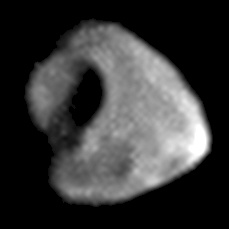 |
116×98×84 | ~43 | 221 889 | +16h 11m 17s | 1.076°[31] | 0.0175 | 1979 | Synnott (Voyager 1) |
Inner |
| 5 | I | Io | ˈaɪ.oʊ |
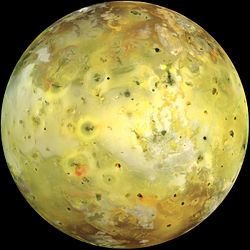 |
3660.0×3637.4 ×3630.6 |
8 900 000 | 421 700 | +1.769 137 786 | 0.050°[31] | 0.0041 | 1610 | Galilei | Galilean |
| 6 | II | Europa | jʊˈroʊpə |
 |
3121.6 | 4 800 000 | 671 034 | +3.551 181 041 | 0.471°[31] | 0.0094 | 1610 | Galilei | Galilean |
| 7 | III | Ganymede | ˈgænɨmiːd |
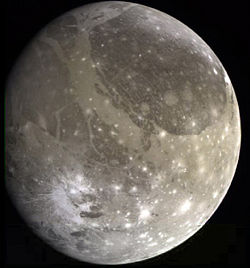 |
5262.4 | 15 000 000 | 1 070 412 | +7.154 552 96 | 0.204°[31] | 0.0011 | 1610 | Galilei | Galilean |
| 8 | IV | Callisto | kəˈlɪstoʊ |
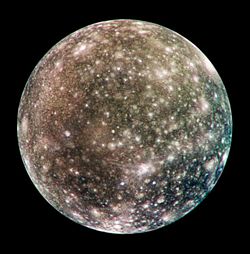 |
4820.6 | 11 000 000 | 1 882 709 | +16.689 018 4 | 0.205°[31] | 0.0074 | 1610 | Galilei | Galilean |
| 9 | XVIII | Themisto | θɨˈmɪstoʊ | 8 | 0.069 | 7 393 216 | +129.87 | 45.762° | 0.2115 | 1975/2000 | Kowal & Roemer/ Sheppard et al. |
Themisto | |
| 10 | XIII | Leda | ˈliːdə | 16 | 0.6 | 11 187 781 | +241.75 | 27.562° | 0.1673 | 1974 | Kowal | Himalia | |
| 11 | VI | Himalia | haɪˈmeɪliə |
|
170 | 670 | 11 451 971 | +250.37 | 30.486° | 0.1513 | 1904 | Perrine | Himalia |
| 12 | X | Lysithea | laɪˈsɪθiə | 36 | 6.3 | 11 740 560 | +259.89 | 27.006° | 0.1322 | 1938 | Nicholson | Himalia | |
| 13 | VII | Elara | ˈɛlərə | 86 | 87 | 11 778 034 | +261.14 | 29.691° | 0.1948 | 1905 | Perrine | Himalia | |
| 14 | — | S/2000 J 11 | 4 | 0.009 0 | 12 570 424 | +287.93 | 27.584° | 0.2058 | 2001 | Sheppard et al. | Himalia | ||
| 15 | XLVI | Carpo | ˈkɑrpoʊ | 3 | 0.004 5 | 17 144 873 | +458.62 | 56.001° | 0.2735 | 2003 | Sheppard et al. | Carpo | |
| 16 | — | S/2003 J 12 | 1 | 0.000 15 | 17 739 539 | −482.69 | 142.680° | 0.4449 | 2003 | Sheppard et al. | ? | ||
| 17 | XXXIV | Euporie | juːˈpɔərɨ.i | 2 | 0.001 5 | 19 088 434 | −538.78 | 144.694° | 0.0960 | 2002 | Sheppard et al. | Ananke | |
| 18 | — | S/2003 J 3 | 2 | 0.001 5 | 19 621 780 | −561.52 | 146.363° | 0.2507 | 2003 | Sheppard et al. | Ananke | ||
| 19 | — | S/2003 J 18 | 2 | 0.001 5 | 19 812 577 | −569.73 | 147.401° | 0.1569 | 2003 | Gladman et al. | Ananke | ||
| 20 | XLII | Thelxinoe | θɛlkˈsɪnoʊ.i | 2 | 0.001 5 | 20 453 753 | −597.61 | 151.292° | 0.2684 | 2003 | Sheppard et al. | Ananke | |
| 21 | XXXIII | Euanthe | juːˈænθi | 3 | 0.004 5 | 20 464 854 | −598.09 | 143.409° | 0.2000 | 2002 | Sheppard et al. | Ananke | |
| 22 | XLV | Helike | ˈhɛlɨki | 4 | 0.009 0 | 20 540 266 | −601.40 | 154.586° | 0.1374 | 2003 | Sheppard et al. | Ananke | |
| 23 | XXXV | Orthosie | ɔrˈθɒsɨ.i | 2 | 0.001 5 | 20 567 971 | −602.62 | 142.366° | 0.2433 | 2002 | Sheppard et al. | Ananke | |
| 24 | XXIV | Iocaste | ˌaɪ.əˈkæsti | 5 | 0.019 | 20 722 566 | −609.43 | 147.248° | 0.2874 | 2001 | Sheppard et al. | Ananke | |
| 25 | — | S/2003 J 16 | 2 | 0.001 5 | 20 743 779 | −610.36 | 150.769° | 0.3184 | 2003 | Gladman et al. | Ananke | ||
| 26 | XXVII | Praxidike | prækˈsɪdɨki | 7 | 0.043 | 20 823 948 | −613.90 | 144.205° | 0.1840 | 2001 | Sheppard et al. | Ananke | |
| 27 | XXII | Harpalyke | hɑrˈpælɨki | 4 | 0.012 | 21 063 814 | −624.54 | 147.223° | 0.2440 | 2001 | Sheppard et al. | Ananke | |
| 28 | XL | Mneme | ˈniːmi | 2 | 0.001 5 | 21 129 786 | −627.48 | 149.732° | 0.3169 | 2003 | Gladman et al. | Ananke | |
| 29 | XXX | Hermippe | hɚˈmɪpi | 4 | 0.009 0 | 21 182 086 | −629.81 | 151.242° | 0.2290 | 2002 | Sheppard et al. | Ananke? | |
| 30 | XXIX | Thyone | θaɪˈoʊni | 4 | 0.009 0 | 21 405 570 | −639.80 | 147.276° | 0.2525 | 2002 | Sheppard et al. | Ananke | |
| 31 | XII | Ananke | əˈnæŋki | 28 | 3.0 | 21 454 952 | −642.02 | 151.564° | 0.3445 | 1951 | Nicholson | Ananke | |
| 32 | — | S/2003 J 17 | 2 | 0.001 5 | 22 134 306 | −672.75 | 162.490° | 0.2379 | 2003 | Gladman et al. | Carme | ||
| 33 | XXXI | Aitne | ˈaɪtni | 3 | 0.004 5 | 22 285 161 | −679.64 | 165.562° | 0.3927 | 2002 | Sheppard et al. | Carme | |
| 34 | XXXVII | Kale | ˈkeɪli | 2 | 0.001 5 | 22 409 207 | −685.32 | 165.378° | 0.2011 | 2002 | Sheppard et al. | Carme | |
| 35 | XX | Taygete | teiˈɪdʒɨti | 5 | 0.016 | 22 438 648 | −686.67 | 164.890° | 0.3678 | 2001 | Sheppard et al. | Carme | |
| 36 | — | S/2003 J 19 | 2 | 0.001 5 | 22 709 061 | −699.12 | 164.727° | 0.1961 | 2003 | Gladman et al. | Carme | ||
| 37 | XXI | Chaldene | kælˈdiːni | 4 | 0.007 5 | 22 713 444 | −699.33 | 167.070° | 0.2916 | 2001 | Sheppard et al. | Carme | |
| 38 | — | S/2003 J 15 | 2 | 0.001 5 | 22 720 999 | −699.68 | 141.812° | 0.0932 | 2003 | Sheppard et al. | Ananke? | ||
| 39 | — | S/2003 J 10 | 2 | 0.001 5 | 22 730 813 | −700.13 | 163.813° | 0.3438 | 2003 | Sheppard et al. | Carme? | ||
| 40 | — | S/2003 J 23 | 2 | 0.001 5 | 22 739 654 | −700.54 | 148.849° | 0.3930 | 2004 | Sheppard et al. | Pasiphaë | ||
| 41 | XXV | Erinome | ɨˈrɪnəmi | 3 | 0.004 5 | 22 986 266 | −711.96 | 163.737° | 0.2552 | 2001 | Sheppard et al. | Carme | |
| 42 | XLI | Aoede | eɪˈiːdi | 4 | 0.009 0 | 23 044 175 | −714.66 | 160.482° | 0.6011 | 2003 | Sheppard et al. | Pasiphaë | |
| 43 | XLIV | Kallichore | kəˈlɪkəri | 2 | 0.001 5 | 23 111 823 | −717.81 | 164.605° | 0.2041 | 2003 | Sheppard et al. | Carme? | |
| 44 | XXIII | Kalyke | ˈkælɨki | 5 | 0.019 | 23 180 773 | −721.02 | 165.505° | 0.2139 | 2001 | Sheppard et al. | Carme | |
| 45 | XI | Carme | ˈkɑrmi | 46 | 13 | 23 197 992 | −721.82 | 165.047° | 0.2342 | 1938 | Nicholson | Carme | |
| 46 | XVII | Callirrhoe | kəˈlɪroʊ.i | 9 | 0.087 | 23 214 986 | −722.62 | 139.849° | 0.2582 | 2000 | Gladman et al. | Pasiphaë | |
| 47 | XXXII | Eurydome | jʊˈrɪdəmi | 3 | 0.004 5 | 23 230 858 | −723.36 | 149.324° | 0.3769 | 2002 | Sheppard et al. | Pasiphaë? | |
| 48 | XXXVIII | Pasithee | pəˈsɪθɨ.i | 2 | 0.001 5 | 23 307 318 | −726.93 | 165.759° | 0.3288 | 2002 | Sheppard et al. | Carme | |
| 49 | XLVIII | Cyllene | sɨˈliːni | 2 | 0.001 5 | 23 396 269 | −731.10 | 140.148° | 0.4115 | 2003 | Sheppard et al. | Pasiphaë | |
| 50 | XLVII | Eukelade | juːˈkɛlədi | 4 | 0.009 0 | 23 483 694 | −735.20 | 163.996° | 0.2828 | 2003 | Sheppard et al. | Carme | |
| 51 | — | S/2003 J 4 | 2 | 0.001 5 | 23 570 790 | −739.29 | 147.175° | 0.3003 | 2003 | Sheppard et al. | Pasiphaë | ||
| 52 | VIII | Pasiphaë | pəˈsɪfeɪ.i | 60 | 30 | 23 609 042 | −741.09 | 141.803° | 0.3743 | 1908 | Gladman et al. | Pasiphaë | |
| 53 | XXXIX | Hegemone | hɨˈdʒɛməni | 3 | 0.004 5 | 23 702 511 | −745.50 | 152.506° | 0.4077 | 2003 | Sheppard et al. | Pasiphaë | |
| 54 | XLIII | Arche | ˈɑrki | 3 | 0.004 5 | 23 717 051 | −746.19 | 164.587° | 0.1492 | 2002 | Sheppard et al. | Carme | |
| 55 | XXVI | Isonoe | aɪˈsɒnoʊ.i | 4 | 0.007 5 | 23 800 647 | −750.13 | 165.127° | 0.1775 | 2001 | Sheppard et al. | Carme | |
| 56 | — | S/2003 J 9 | 1 | 0.000 15 | 23 857 808 | −752.84 | 164.980° | 0.2761 | 2003 | Sheppard et al. | Carme | ||
| 57 | — | S/2003 J 5 | 4 | 0.009 0 | 23 973 926 | −758.34 | 165.549° | 0.3070 | 2003 | Sheppard et al. | Carme | ||
| 58 | IX | Sinope | sɨˈnoʊpi | 38 | 7.5 | 24 057 865 | −762.33 | 153.778° | 0.2750 | 1914 | Nicholson | Pasiphaë | |
| 59 | XXXVI | Sponde | ˈspɒndi | 2 | 0.001 5 | 24 252 627 | −771.60 | 154.372° | 0.4431 | 2002 | Sheppard et al. | Pasiphaë | |
| 60 | XXVIII | Autonoe | ɔːˈtɒnoʊ.i | 4 | 0.009 0 | 24 264 445 | −772.17 | 151.058° | 0.3690 | 2002 | Sheppard et al. | Pasiphaë | |
| 61 | XLIX | Kore | ˈkɔəri | 2 | 0.001 5 | 23 345 093 | −776.02 | 137.371° | 0.1951 | 2003 | Sheppard et al. | Pasiphaë | |
| 62 | XIX | Megaclite | ˌmɛgəˈklaɪti | 5 | 0.021 | 24 687 239 | −792.44 | 150.398° | 0.3077 | 2001 | Sheppard et al. | Pasiphaë | |
| 63 | — | S/2003 J 2 | 2 | 0.001 5 | 30 290 846 | −1 077.02 | 153.521° | 0.1882 | 2003 | Sheppard et al. | ? |
See also
- Galilean moons
- Jupiter's moons in fiction
- Rings of Jupiter
- Natural satellites of Earth · Mars · Saturn · Uranus · Neptune
Notes
- ↑ Order refers to the position among other moons with respect to their average distance from Jupiter.
- ↑ Label refers to the Roman numeral attributed to each moon in order of their discovery.
- ↑ Diameters with multiple entries such as "60×40×34" reflect that the body is not a perfect spheroid and that each of its dimensions have been measured well enough.
- ↑ Periods with negative values are retrograde.
- ↑ "?" refers to group assignments that are not considered sure yet.
References
- ↑ "Solar System Bodies". JPL/NASA. Retrieved on 2008-09-09.
- ↑ Xi, Zezong Z. (1981). "The Discovery of Jupiter's Satellite Made by Gan De 2000 years Before Galileo". Acta Astrophysica Sinica 1 (2): 87.
- ↑ Galilei, Galileo (1989). Translated and prefaced by Albert Van Helden. ed.. Sidereus Nuncius. Chicago & London: University of Chicago Press. pp. 14–16. ISBN 0226279030.
- ↑ Van Helden, Albert (March 1974). "The Telescope in the Seventeenth Century". Isis (The University of Chicago Press on behalf of The History of Science Society) 65 (1): 38–58. doi:.
- ↑ Barnard, E. E. (1892). "Discovery and Observation of a Fifth Satellite to Jupiter". Astronomical Journal 12: 81–85. doi:. http://adsabs.harvard.edu//full/seri/AJ.../0012//0000081.000.html.
- ↑ "Discovery of a Sixth Satellite of Jupiter". Astronomical Journal 24 (18): 154B;. 1905-01-9. doi:. http://adsabs.harvard.edu//full/seri/AJ.../0024//0000154I002.html.
- ↑ Perrine, C. D. (1905). "The Seventh Satellite of Jupiter". Publications of the Astronomical Society of the Pacific 17 (101): 62–63. http://adsabs.harvard.edu//full/seri/PASP./0017//0000062.000.html.
- ↑ Melotte, P. J. (1908). "Note on the Newly Discovered Eighth Satellite of Jupiter, Photographed at the Royal Observatory, Greenwich". Monthly Notices of the Royal Astronomical Society 68 (6): 456–457. http://adsabs.harvard.edu/cgi-bin/nph-data_query?bibcode=1908MNRAS..68..456.&db_key=AST&link_type=ABSTRACT&high=40daf3f6f927275.
- ↑ Nicholson, S. B. (1914). "Discovery of the Ninth Satellite of Jupiter". Publications of the Astronomical Society of the Pacific 26: pp. 197–198. doi:. http://adsabs.harvard.edu//full/seri/PASP./0026//0000197.000.html.
- ↑ Nicholson, S.B. (1938). "Two New Satellites of Jupiter". Publications of the Astronomical Society of the Pacific 50: 292–293. doi:. http://adsabs.harvard.edu//full/seri/PASP./0050//0000292.000.html.
- ↑ Nicholson, S. B. (1951). "An unidentified object near Jupiter, probably a new satellite". Publications of the Astronomical Society of the Pacific 63 (375): 297–299. doi:. http://adsabs.harvard.edu//full/seri/PASP./0063//0000297.000.html.
- ↑ Kowal, C. T.; Aksnes, K.; Marsden, B. G.; and Roemer, E. (1974). "Thirteenth satellite of Jupiter". Astronomical Journal 80: pp. 460–464. doi:. http://adsabs.harvard.edu//full/seri/AJ.../0080//0000460.000.html.
- ↑ Marsden, Brian G. (3 October 1975). "Probable New Satellite of Jupiter" (discovery telegram sent to the IAU). International Astronomical Union Circulars (Cambridge, US: Smithsonian Astrophysical Observatory) 2845. http://cfa-www.harvard.edu/iauc/02800/02845.html. Retrieved on 2008-09-03.
- ↑ Synnott, S.P. (1980). "1979J2: The Discovery of a Previously Unknown Jovian Satellite". Science 210 (4471): 786–788. doi:. PMID 17739548.
- ↑ 15.0 15.1 15.2 15.3 "Gazetteer of Planetary Nomenclature". Working Group for Planetary System Nomenclature (WGPSN). U.S. Geological Survey (2008-11-07). Retrieved on 2008-08-02.
- ↑ 16.0 16.1 16.2 16.3 16.4 Sheppard, Scott S.; Jewitt, David C. (May 5, 2003). "An abundant population of small irregular satellites around Jupiter". Nature 423: 261–263. doi:.
- ↑ 17.0 17.1 17.2 17.3 17.4 Sheppard, Scott S.. "Jupiter's Known Satellites". Departament of Terrestrial Magnetism at Carniege Institution for science. Retrieved on 2008-08-28.
- ↑ 18.0 18.1 Marazzini, C. (2005). "The names of the satellites of Jupiter: from Galileo to Simon Marius" (in Italian). Lettere Italiane 57 (3): 391–407. ISSN 0024-1334.
- ↑ Nicholson, Seth Barnes (April 1939). "The Satellites of Jupiter". Publications of the Astronomical Society of the Pacific 51 (300): 85–94. doi:. http://adsabs.harvard.edu//full/seri/PASP./0051//0000093.000.html.
- ↑ Payne-Gaposchkin, Cecilia; Haramundanis, Katherine (1970). Introduction to Astronomy. Englewood Cliffs, N.J.: Prentice-Hall. ISBN 0-134-78107-4.
- ↑ 21.0 21.1 Marsden, Brian G. (03 October 1975). "Satellites of Jupiter". International Astronomical Union Circulars 2846. http://cfa-www.harvard.edu/iauc/02800/02846.html#Item6. Retrieved on 2008-08-28.
- ↑ 22.0 22.1 Satellites of Jupiter, Saturn and Uranus . International Astronomical Union. Report. Retrieved on 2008-08-28.
- ↑ Anderson, J.D.; Johnson, T.V.; Shubert, G.; et.al. (2005). "Amalthea’s Density Is Less Than That of Water". Science 308: 1291–1293. doi:. PMID 15919987. http://adsabs.harvard.edu/abs/2005Sci...308.1291A.
- ↑ Burns, J.A.; Simonelli, D. P.; Showalter, M.R. et.al. (2004). "Jupiter’s Ring-Moon System". in Bagenal, F.; Dowling, T.E.; McKinnon, W.B.. Jupiter: The Planet, Satellites and Magnetosphere. Cambridge University Press.
- ↑ Burns, J. A.; Showalter, M. R.; Hamilton, D. P.; et al. (1999). "The Formation of Jupiter's Faint Rings". Science 284: 1146–1150. doi:.
- ↑ Canup, Robin M.; Ward, William R. (2002). "Formation of the Galilean Satellites: Conditions of Accretion" (pdf). The Astronomical Journal 124: 3404–3423. doi:. http://www.boulder.swri.edu/~robin/cw02final.pdf.
- ↑ 27.0 27.1 27.2 27.3 Grav, Tommy; Holman, Matthew J.; Gladman, Brett J.; Aksnes, Kaare (2003). "Photometric survey of the irregular satellites". Icarus 166 (1): 33–45. doi:.
- ↑ Sheppard, Scott S.; Jewitt, David C.; Porco, Carolyn (2004). "Jupiter's outer satellites and Trojans". in Fran Bagenal, Timothy E. Dowling, William B. McKinnon (pdf). Jupiter. The planet, satellites and magnetosphere. 1. Cambridge, UK: Cambridge University Press. pp. 263 - 280. ISBN 0-521-81808-7. http://www.ifa.hawaii.edu/~jewitt/papers/JUPITER/JSP.2003.pdf.
- ↑ Nesvorný, David; Beaugé, Cristian; Dones, Luke (2004). "Collisional Origin of Families of Irregular Satellites" (PDF). The Astronomical Journal 127: 1768–1783. doi:. http://www.boulder.swri.edu/~davidn/papers/irrbig.pdf.
- ↑ 30.0 30.1 30.2 "Natural Satellites Ephemeris Service". IAU: Minor Planet Center. Retrieved on 2008-09-03. "Note: some semi-major axis were computed using the µ value, while the eccentricities were taken using the inclination to the local Laplace plane"
- ↑ 31.0 31.1 31.2 31.3 31.4 31.5 31.6 31.7 Siedelmann P.K.; Abalakin V.K.; Bursa, M.; Davies, M.E.; de Bergh, C.; Lieske, J.H.; Obrest, J.; Simon, J.L.; Standish, E.M.; Stooke, P. ; Thomas, P.C. (2000) The Planets and Satellites 2000 . IAU/IAG Working Group on Cartographic Coordinates and Rotational Elements of the Planets and Satellites. Report. Retrieved on 2008-08-31.
External links
- Jupiter's Moons by NASA's Solar System Exploration
- "43 more moons orbiting Jupiter" article appeared in 2003 in the San Francisco Chronicle
- Articles on the Jupiter System in Planetary Science Research Discoveries
|
||||||||||||||||||||||||||||||||||||||||
|
||||||||||||||||
|
|||||||||||||||||
|
|||||||||||||||||
